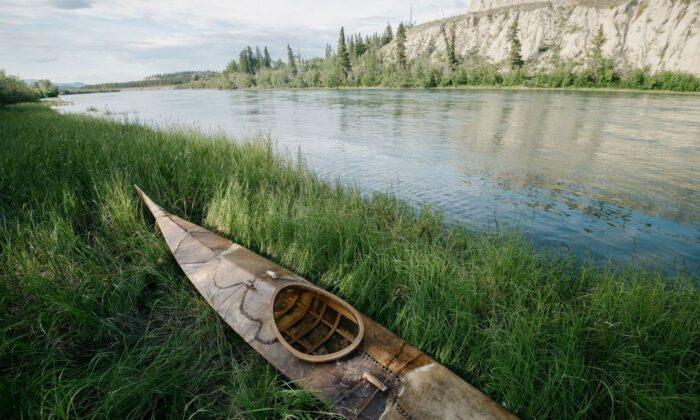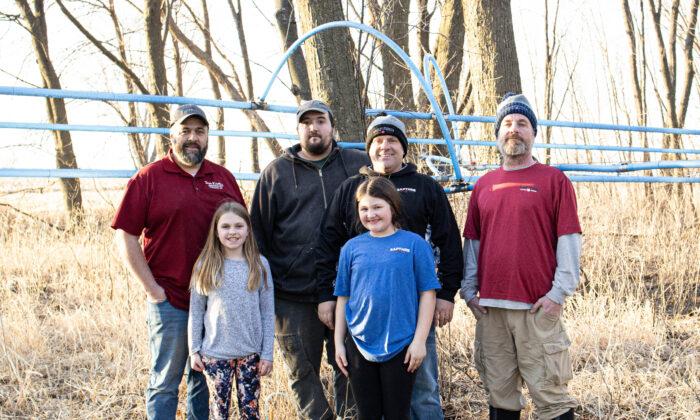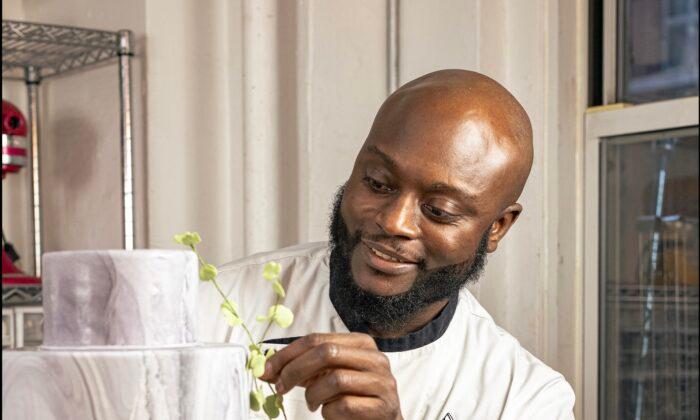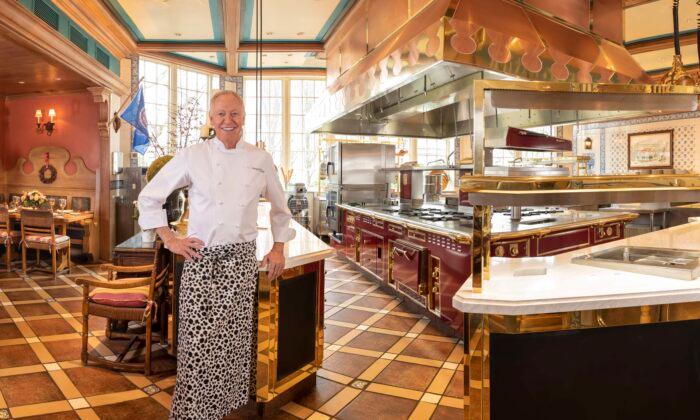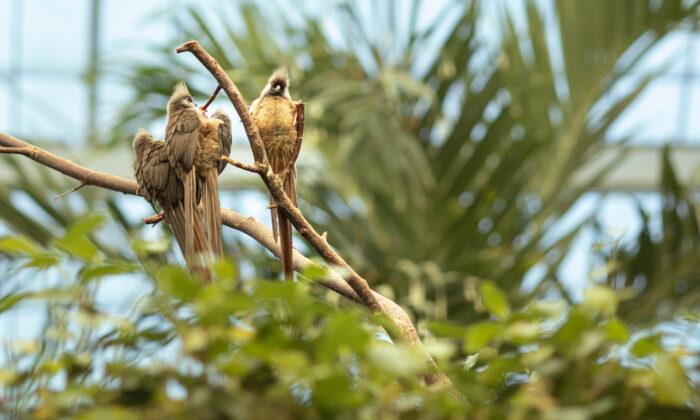“If you hunt something, how can you love it? How can you both love an animal and hunt it?”
These words of National Geographic photographer and indigenous kayak craftsman Kiliii Yuyan reverberated in my mind as I floated down the Cedar River in Iowa on my last kayak trip of the year. It was early, just after 7 a.m., and dense mist hovered above the water, reluctant to let dawn give in to day. By this morning in late October, the wind that rattled near-naked tree limbs was brisk. Just a few months ago, I made this same exact float with thighs burning under the sun, but now, at the threshold of winter, I huddled in my trusty North Face fleece and let the steam wafting from my open coffee thermos warm my poor, red nose.
Gray, wintry waves lurched at the hull of my kayak. She’s a humble vessel, 10 feet of yellow polyethylene purchased at a big-box outdoors store, and was currently the only thing separating me from a 40-something-degree polar plunge. While this was not something I’d ever been particularly aware of in any of my countless prior kayak trips, Yuyan made me painfully conscious of a kayaker’s vulnerable position; with me being mostly submerged in the vessel and the vessel being mostly submerged in the water, who’s to say where I, the boat, and the river all began and ended?
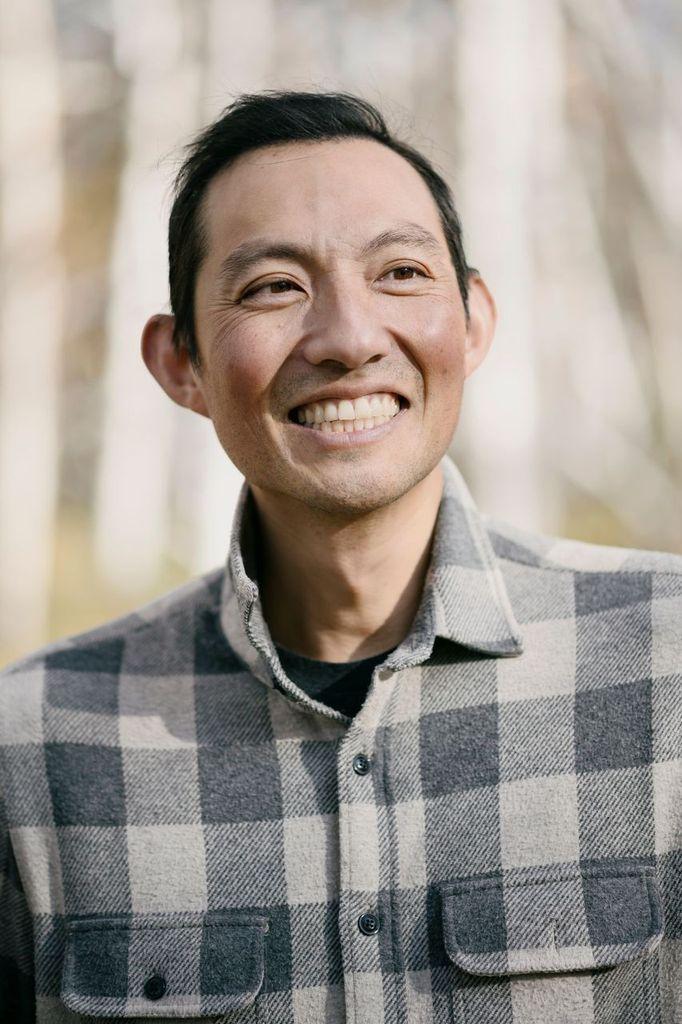
Yuan is also a photographer whose work has been published in National Geographic. Courtesy of Kiliii Yuyan - Photo by Princess Dazrahi Johnson
From somewhere beyond the bank, a mourning dove cooed. And in a shallow portion a few dozen yards ahead, a deer crashed through the water, hustling to the other side. At the sight of the doe, I was reminded, again, of Yuyan’s questions to me a few days prior.
Can you love something that you hunt, that you kill? Can you respect it? Do you think the animal giving its life to you respects you?
Small, but Mighty
Yuyan, a resident of Seattle, is Chinese-American and Nanai-American. Nanai is an indigenous people native to Siberia. His parents were immigrants to the United States fleeing the communist revolution in China. With a mother that was fearful of the consequences of being different, Yuyan spent his childhood years ignorant of his indigenous heritage, only catching glimpses of his background when Grandma would come to visit and share hushed stories of the culture that pulsed through his veins. After discovering his heritage, Yuyan dove into many traditional practices, such as fishing, hunting, buckskin tanning, basket weaving, and clay pottery. One in particular has flourished into a global business, preserving an indigenous tradition that has changed the course of marine navigation: the art of building kayaks. Kayaks are a cornerstone in indigenous peoples’ connections with each other, the earth, and the animals that they hunt on it. “A lot of different northern cultures have powerful ties and spiritual relationships with kayaks,” Yuyan told me.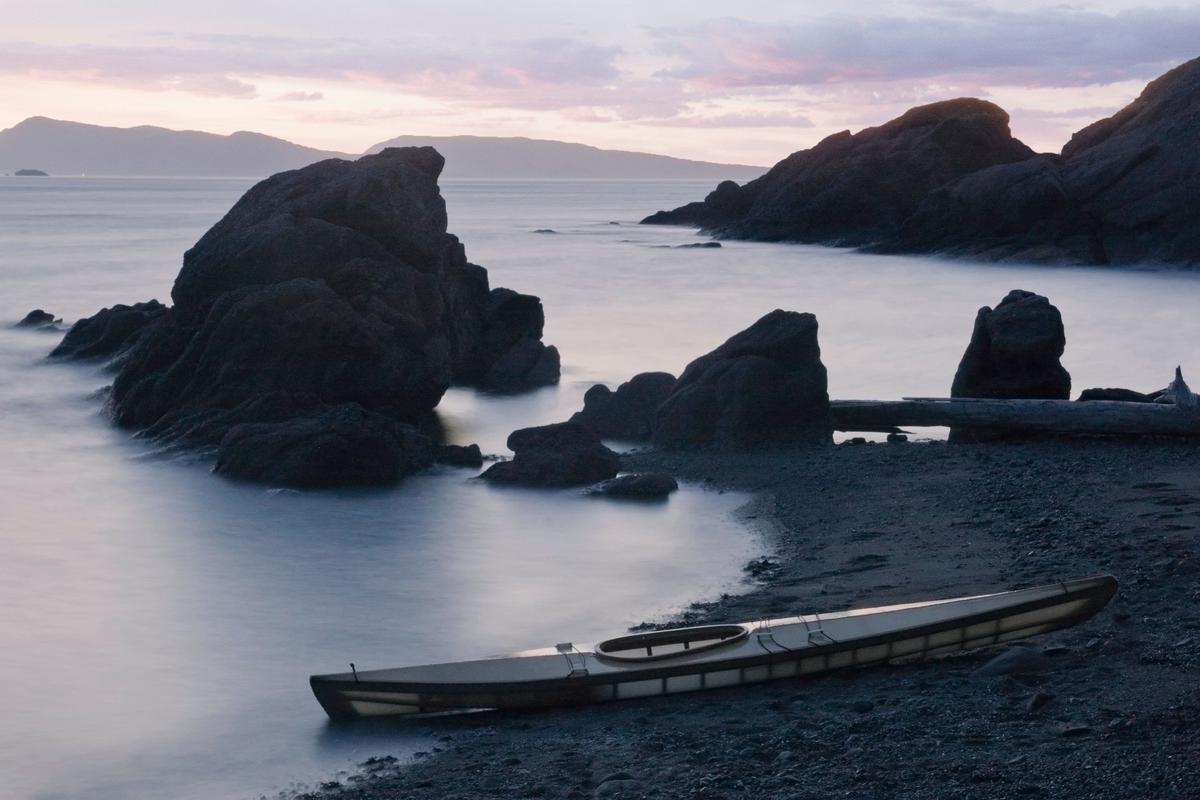
Dusk falls over the water on Orcas Island, Wash. Yuyan is a frequent visitor to the upper Pacific, where he encounters seals, whales, and orcas. Kiliii Yuyan
Starkly different from my mass-produced plastic vessel, Yuyan’s kayaks are made in the way that ancient Arctic and Subarctic natives (who had migrated from Asia and Siberia to what is now upper Alaska and Canada) did to navigate the dangerously icy waters they hunted in. He follows 4,000-year-old methods: Cold-weather tribes used birch branches—lashed together with hand-tied knots—and seal skins to assemble their kayaks, creating a vessel capable of going where others could not. The people depended largely on hunting in the ocean, but capsizing in the Arctic meant instant death if they couldn’t right their boat and get back inside within 30 seconds. Regarded as one of the pinnacles of indigenous technologies, the kayak represented the height of what was possible at the time of its invention. And yet the traditional boat is “not rocket science,” Yuyan said, but rather “just a basket,” with its lack of metal reinforcement and absence of modern boat materials.
“The real sophistication comes in how the parts are put together and how the joints are attached. The joinery is a really huge part of assembly, as well as design. The ways in which the boat is bowed and, well, not a basket shape-wise—that’s where all the magic is.”
Some of Yuyan’s kayaks are made for cultural events, while others are built for recreation or function. One kayak takes Yuyan about six days to finish, but novices and DIYers can expect to invest thousands of hours in crafting their vessel. He uses western red cedar and bamboo for his frames, and seal, caribou, or cow—“land walrus,” Yuyan said with a laugh—for the skin in cultural kayaks. In his traditional kayaks built for function, ballistic nylon is used for the skin instead.
Yuyan’s team teaches people across the world how to make traditional Nanai kayaks and preserve the knowledge of his culture. For the last 15 years, he’s taught classes across the United States, Canada, and Europe, and he will soon be teaching in Australia and New Zealand. His kayaks are sold individually as well through his business, Seawolf Kayak.
The Kayak Comeback
Modern-day interest in these ancient vessels has increased in recent years: indigenous people in the far north have begun building them again, and the desire to seal-hunt from traditional kayaks has increased. Yuyan says that a lot of the kayak resurgence is just because of interest in history, but there’s more at play. The question surfaces of why these traditional methods withstand the test of time when mass-production offers simpler, cheaper, more uniform options. The same can be asked in any culture, whether indigenous, Chinese, European, or any other: why do our traditions continue year after year? It’s certainly not because they cost any less money or are any easier to produce. Ancestral hunters in Greenland used to say that their kayaks were spiritual brothers, sharing the same life force. A man without a kayak was not considered an eligible bachelor.The connection between a kayak hunter and his vessel, Yuyan said, is deeply spiritual. This is where he begged the earlier question of love between the hunter and the hunted. I pondered whether the same can be said of the orange vests and shotgun shells I know of Midwestern hunting. Do we love and respect our bounties? I fondly remember my father, who often sits in his hunting blind for hours watching deer meander by, before even loading his gun. Kayaks connect hunters with the water, the animals, and each other. Perhaps we could take lessons in flexibility from these vessels and learn to offer some bend where it might be easier to stay rigid; a cedar-boned kayak moves differently and more quietly than a polyethylene one. Whereas the latter is a stiff barrier to the water below, traditional kayaks are creatures that move with the waves: Flexible bones and thin skin allow the kayak to gently bend with each ebb and flow.
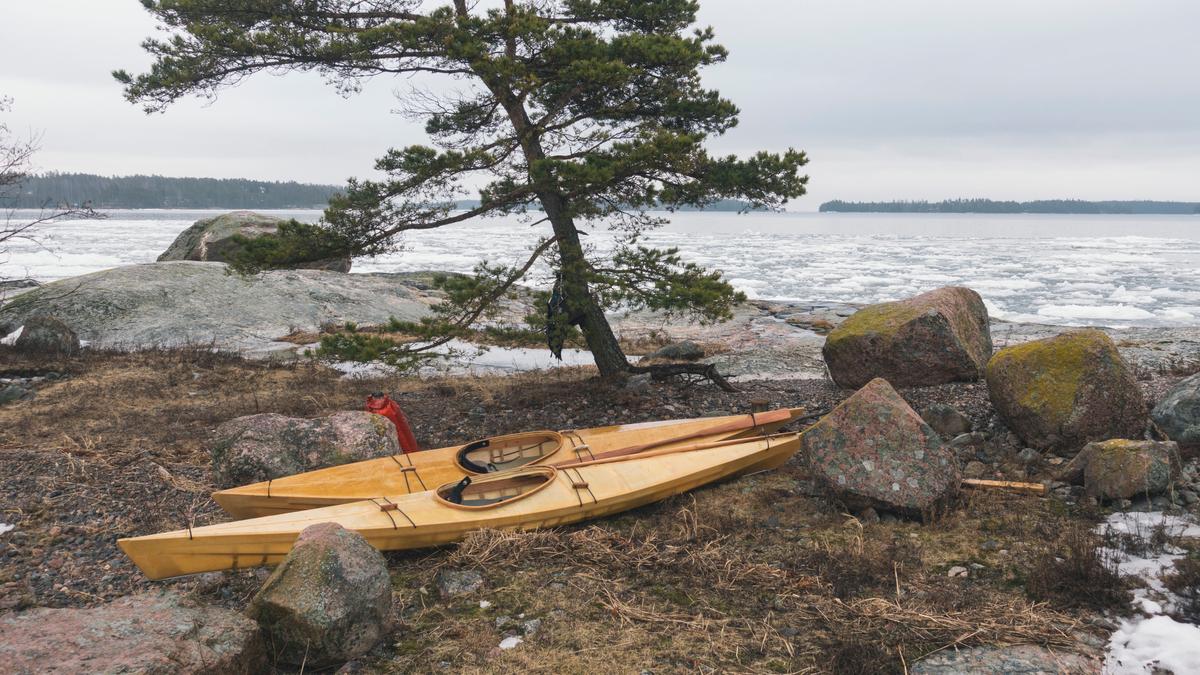
Kayaks made by one of Yuyan's students, Robin Falck, await the water at a site near Sipoo, Finland. Yuan's students can take several weeks or months to complete their first kayaks. Kiliii Yuyan
Hunting is a necessary practice that commands respect from the hunters. The Nanai used to sing to marine animals as they hunted them. The tradition goes, the animals would decide if they wanted to surrender to your hunt based on how beautiful your kayak was, and how well you sang. Yuyan, using the advice of his ancestors, sings The Beatles to the orcas when he’s paddling in the San Juan Islands (the only way he’s shooting the orcas is with his camera—these creatures aren’t hunted nowadays), and, surely enough, a curious orca calf will swim up to bump the underside of his kayak. Kayakers can even feel the vibrations when the calf echolocates from underneath the vessel. The orcas respond to the singing from even a couple miles away, being as sensitive to acoustics as they are.
“You can feel the change in pressure as they dart back and forth. The kayak is flexible, so one of the coolest things about traditional kayaks is that you feel things from underneath, like ocean life. It’s one of my favorite experiences.”
With a nickname like “killer whale,” it’s easy to be afraid of the orca, but Yuyan says he can feel their playful energy. After all, he has his partner, lifeline, and protector: his kayak. It weighs less than 30 pounds, contains no metal or electronics, and can outlast fiberglass under the brute force of ocean waves. Boats like his are used to hunt bowhead whales in Alaska; they are covered with seal skin and sewn together with caribou sinew. The vessels connect dozens of people: seal hunters, seal skinners, caribou hunters, sinew twiners, women who sew the skins together, and whalers.
“Every step along the way, there’s a direct connection with the land, a direct connection that goes back to requiring you to be out on the land, having a relationship with these animals.”
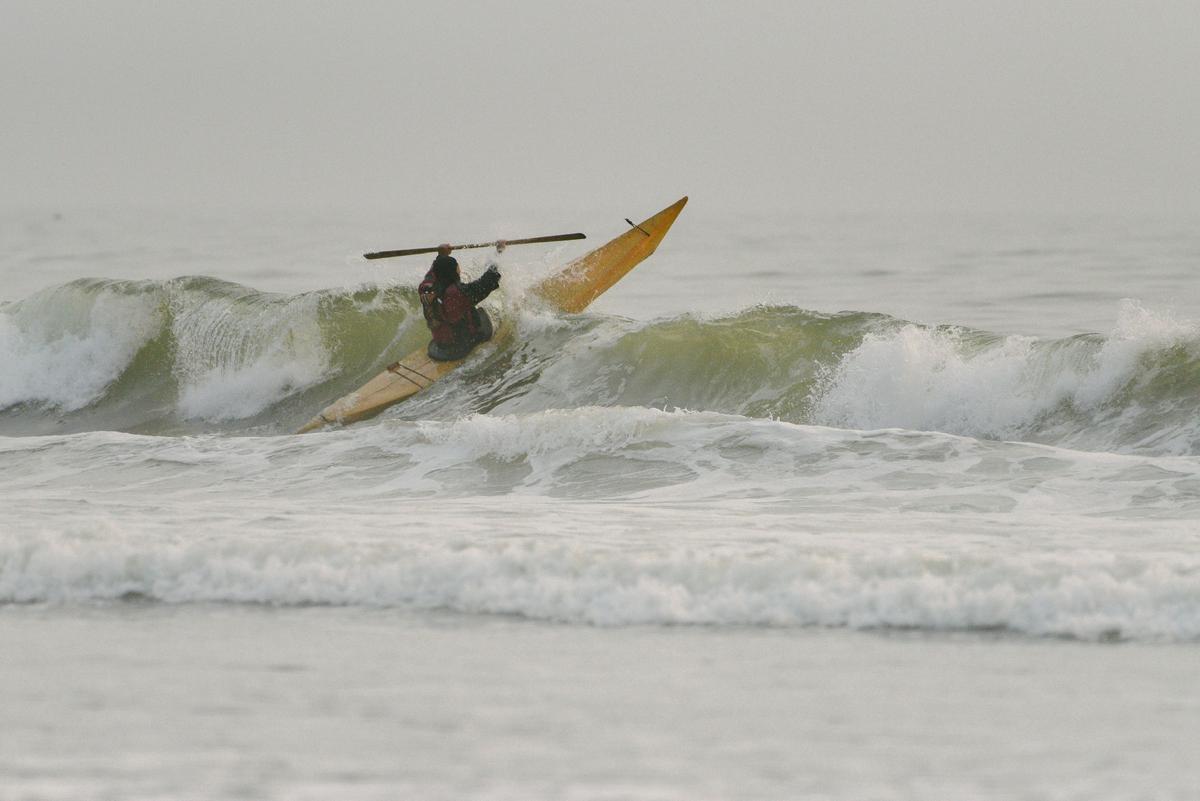
A kayaker crashes through the surf in one of Yuyan's handmade vessels. These kayaks contain no metal hardware, plastic, or vinyl; all of Yuyan's work is bound via traditional knotting methods. Kiliii Yuyan
Traditions teach us lessons. They bring us full circle back to our relationships with each other and other creatures. The kayak made in a man’s shop rather than a company’s factory teaches us that, even though we hunt animals to sustain ourselves, we should also be caring for them at the same time. So, Yuyan’s response to the question about love and respect is: “How can you possibly hunt for something if you don’t love it?” Indigenous hunters, for example, collect goose eggs out of nests, but they also dig moats around the nests to protect the remaining eggs from arctic foxes. The hunters take life and they also protect it.
At the center of this ancient relationship is the kayak, lost in Alaskan native practice over the last century as motors and modern boats took the lead, but making a comeback through efforts like Yuyan’s. He builds the vessels with only his two hands, but 4,000 years of knowledge are behind him.
“I’m bringing the kayak back, by teaching Iñupiat teenagers how to build them in school. We’ll lash those frames together, strong and light. We’ll sew bearded sealskins around them,” Yuyan once wrote in a blog post in Filson Journal. “We’ll bring those kayaks to life just as they did in the old days, before aluminum and gasoline. We’ll take part in the cycle of Native tradition, passing forward our knowledge the way it’s been done since the beginning. In this way, our stories live on.”
This article was originally published in American Essence magazine.

